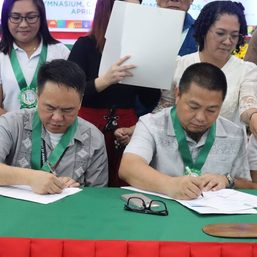SUMMARY
This is AI generated summarization, which may have errors. For context, always refer to the full article.
![[ANALYSIS] How the Marcos gov’t lies with statistics](https://www.rappler.com/tachyon/2023/07/tl-marcos-govt-stat-lies.jpg)
When Ferdinand E. Marcos was dictator of the Philippines from the early 1970s to the early 1980s, government statistics were misused and abused in various ways to hide the true state of the economy.
For instance, certain surveys and statistics, like official poverty data, were suppressed to hide poverty that was fast rising. (A finding that economists would later have to triangulate using other data sources.)
Then there was the infamous window-dressing of the old Central Bank of the Philippines (CB). Under the direction of former governor Jaime Laya, the books of the CB were padded with $600 million to make it appear that the Marcos dictatorship still had ample international reserves (basically, supply of dollars). In fact, our dollar reserves were severely depleted due to the wanton accumulation of debt, coupled with huge import bills.
Fast forward to 2023, under the presidency of Ferdinand Marcos Jr., is there any evidence that statistics are being misused to conceal the real state of the economy?
Yes. Let’s look at the ways.
Tourism stats
The first instance is pretty new, actually. It involves the Department of Tourism (DOT), under the leadership of Secretary Christina Frasco (daughter of Cebu Governor Gwen Garcia, and former spokesperson of Vice President Sara Duterte).
On July 5, 2023, Secretary Frasco posted on Instagram a number of graphics showing “robust numbers” from the Philippine Statistics Authority, supposedly showing that “Philippine tourism is well on the road to recovery, the Philippines is back, the Philippines is open and ready to tell the Filipino story…”


These statistics were also showcased in a huge event where the DOT confirmed that it would continue to use the new and extremely controversial tourism slogan, “Love the Philippines.”
At first glance, the statistics seem impressive. But in fact, a review of the full data shows that the DOT conveniently omitted the pre-pandemic years and, in doing so, hid the fact that tourism hasn’t really bounced back to pre-pandemic levels.
In other words, the tourism sector isn’t doing as well as the DOT is presenting. Some window-dressing is happening here.
Let’s look at the claims.
First, total spending on tourism (by locals and foreigners) supposedly grew by 131.2% from 2021 to 2022, while domestic tourism spending rose by 92.3% over the same period.
But in fact, Figure 1 shows that the 2022 figures are still nowhere near the spending levels in 2019, before the pandemic. The huge growth rates are in fact the result of so-called “base effects”: tourism crashed so much in 2020 that any recovery – even slight – would naturally register as a high growth rate.
The DOT hid this fact by truncating the x-axis and showing data from just 2020, 2021, and 2022.
Figure 1.
Second, the share of tourism in GDP supposedly increased to 6.2%, from 5.1% in 2020 and 5.2% in 2021. The title of the graphic is, “Tourism is a major contributor to Philippines’ GDP.”

But in fact, Figure 2 shows that 6.2% is less than half the share of tourism in 2019, which was 12.9%. We’re a long way from that sizable contribution to GDP before COVID-19.
Figure 2.
Third, the DOT showed that there was a “boost in tourism-related employment,” and the total number of people in tourism reached 5.35 million in 2022.

But again, the fuller dataset (Figure 3) shows that, in fact, tourism employment peaked in 2019 at 5.72 million. We’re just on the way back to that level.
Figure 3.
To be fair, Secretary Frasco did say that “Philippine tourism is well on the road to recovery.” But she also said, “the Philippines is back” (where did we go?), and to some this may sound as if tourism has recovered fully – when in fact it hasn’t.
The data presented are technically correct. But by omitting other crucial data points, such graphs can be utterly misleading and deceptive.
Secretary Frasco said on her IG post, “Data, numbers, facts are incontrovertible. They are infallible to opinion, they speak for themselves…” But in fact, in the wrong hands, numbers and statistics can very well be used to spread mistruths.
Inflation stats
Meanwhile, on July 4, 2023, President Marcos Jr. himself posted on Twitter a graph showing that inflation has gone down to 5.4% in June 2023, from 8.7% in January 2023.
The accompanying caption in Filipino read: “We continue to protect Filipinos’ ‘purchasing power!’ The continued decline of the country’s inflation rate, which is now at 5.4%, proves that our steps to strengthen the economy and support consumers, workers, and businesses are effective.”

But what does the graph prove, exactly?
Again, the data are technically correct. But the omission of crucial data could easily warp people’s perception of what’s really happening.
First, note that inflation has been going down worldwide of late (Figure 4). The decline of inflation in the Philippines is part of this global decline of inflation, now that global supply chain bottlenecks have eased, among other factors.
In other words, it may be misleading for the President to take so much credit for the decline of inflation.
Figure 4.
More importantly, inflation should not have spiked to 8.7% in the first place.
The President’s graph conveniently omits the other part of the story: inflation went up steeply from 6.4% in July 2022 (Marcos’ first month in office) all the way up to 8.7% in January 2023. For context, 8.7% is more than double the government’s upper inflation target of 4%.
This raises the question: Did the Marcos administration do anything substantive to try to bring down inflation? The quick answer: No. (READ: [ANALYSIS] The economy during Marcos’ first year)
Let’s look at the policy responses.
First, the Marcos administration reintroduced and repurposed Kadiwa stores, Martial Law-era stores that sell cheap commodities. But there weren’t nearly enough of these Kadiwa stores, and most Filipinos cannot benefit from the supposedly lower prices. Moreover, in some outlets, prices of food are still quite high.
The Marcos administration also resorted to greater importation of certain food like onions and sugar. But these were either overly delayed or marred by cartels that keep prices artificially high due to, say, hoarding.
Marcos set up an inter-agency committee on inflation, but this was formed in late May, just as inflation was already going down in earnest.
Growth stats
Finally, the President on May 27, 2023 boasted that the Philippines is now the “fastest growing country in the world.”
Before this, on February 21, the President shared on social media that the Philippines “ranks #1 in ASEAN” in terms of GDP forecast.

Then in January at Davos, the President shared the “good news” that the Philippines is “leading economic recovery and performance not only in the Asia-Pacific but also in the whole world.”
There are inaccuracies galore.
Global data show that in 2022, we were just the 9th fastest growing country, beaten by the likes of Fiji, Malaysia, and Vietnam. This instantly debunks the notion that we’re leading global growth.
As for the ASEAN claim, the GDP growth forecast is not the same as actual GDP growth. And the infographic shown by the President included India and China – even if these countries are obviously not from ASEAN. (They later changed this to “ranks #1 in Asia.”)
Clearly, there have been sloppy efforts to window-dress the Philippine economy. Sure, it’s not bad to promote the country to foreigners or boast about the government’s achievements. But first, let’s make sure those really are achievements, and second, let’s hope that their boasting doesn’t come at the expense of the truth. – Rappler.com
JC Punongbayan, PhD is an assistant professor at the UP School of Economics and the author of False Nostalgia: The Marcos “Golden Age” Myths and How to Debunk Them. JC’s views are independent of his affiliations. Follow him on Twitter (@jcpunongbayan) and Usapang Econ Podcast.
Add a comment
How does this make you feel?

![[ANALYSIS] How one company boosts farmer productivity inside the farm gate](https://www.rappler.com/tachyon/2024/06/bioprime-farmgate-farmer-productivity-boost.jpg?resize=257%2C257&crop=465px%2C0px%2C1080px%2C1080px)

![[In This Economy] Is the Philippines quietly getting richer?](https://www.rappler.com/tachyon/2024/04/20240426-Philippines-quietly-getting-richer.jpg?resize=257%2C257&crop=194px%2C0px%2C720px%2C720px)
![[In This Economy] Can the PH become an upper-middle income country within this lifetime?](https://www.rappler.com/tachyon/2024/04/tl-ph-upper-income-country-04052024.jpg?resize=257%2C257&crop=295px%2C0px%2C720px%2C720px)





![[In This Economy] Marcos’ POGO ban is popular, but will it work?](https://www.rappler.com/tachyon/2024/07/thought-leaders-marcos-pogo-ban.jpg?resize=257%2C257&crop=255px%2C0px%2C720px%2C720px)
![[Rappler Investigates] POGOs no-go as Typhoon Carina exits](https://www.rappler.com/tachyon/2024/07/newsletter-graphics-carina-pogo.jpg?resize=257%2C257&crop=424px%2C0px%2C1080px%2C1080px)



There are no comments yet. Add your comment to start the conversation.